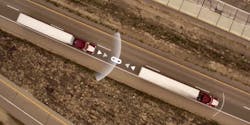Report proposes state exemptions to facilitate platooning, autonomous tech
Automated vehicle technology offers the promise of fewer highway fatalities and big cost savings in transporting consumer goods nationwide, but state driving laws remain a roadblock, according to a new report from the Competitive Enterprise Institute (CEI).
“Trucks move more than $12 trillion worth of goods annually in the U.S., and automated trucking technology could mean big savings in fuel and labor costs,” said Marc Scribner, CEI fellow and author of Authorizing Automated Vehicle Platooning: A Guide for State Legislators. “But we won’t see those gains unless state lawmakers amend current driving laws and regulations that restrict or prohibit automated ‘platooning.’”
Automated vehicle platooning—often referred to as road trains, connected automated vehicles, or cooperative automated vehicles—is one of the more promising potential functions of automated vehicle technology, the report explains. It’s a system that uses communications and computer direction systems to close the gap between vehicles while still allowing them to move safely at highway speeds. That means increased capacity on existing roads, reduced fuel consumption, and eventual gains in highway safety.
“Technology that reduces human involvement—and thus human error—in the operation of a vehicle has the potential to save tens of thousands of lives in the United States every year,” said Scribner.
According to the National Highway Traffic Safety Administration, 35,200 people died on the roads last year, and driver error is the critical factor in 94 percent of crashes.
The CEI report offers specific, state-by-state fixes to amend statutes in a way that exempts computer-coordinated vehicle platooning from “following too closely” driving laws. It is a product of the first nationwide inventory of state following too closely rules, which was conducted by CEI in 2016.
Utah and Florida have already established limited platooning pilot programs, and other states are considering similar moves. But in Missouri, Gov. Jay Nixon (D)—against the wishes of state lawmakers, technology developers, and safety experts—vetoed similar pilot program legislation.
“It is important to note that this does not answer every potential question related to automated vehicle platooning, let alone vehicle automation more broadly,” Scribner writes in his blog. “But we believe automated vehicle platooning, particularly with respect to heavy trucks, offers an important near-term step toward highway vehicle automation.”
